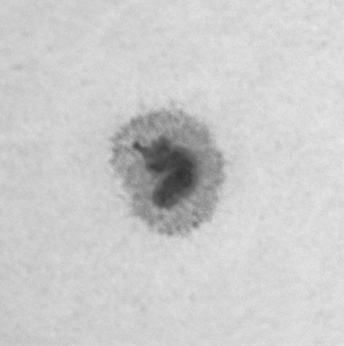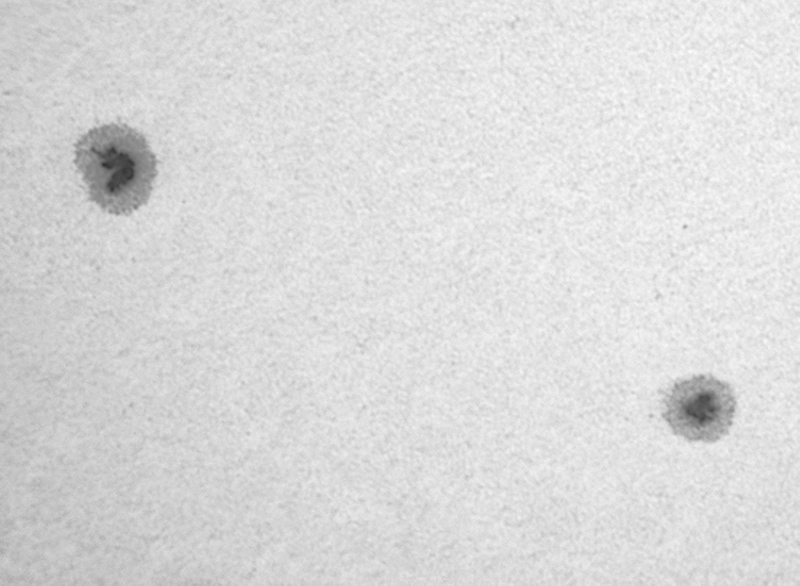 Sunspots are temporary phenomena on the photosphere of the Sun that appear visibly as dark spots compared to surrounding regions. They are caused by intense magnetic activity, which inhibits convection, forming areas of reduced surface temperature. Although they are at temperatures of roughly 3000–4500 K (2727–4227 °C), the contrast with the surrounding material at about 5780 K (5500 °C) leaves them clearly visible as dark spots. Sunspots expand and contract as they move across the surface of the Sun and can be as large as 80,000 kilometers (50,000 mi) in diameter, making the larger ones visible from Earth without the aid of a telescope. They may also travel at relative speeds ("proper motions") of a few hundred m/s when they first emerge onto the solar photosphere.
Manifesting intense magnetic activity, sunspots host secondary phenomena such as coronal loops (prominences) and reconnection events. Most solar flares and coronal mass ejections originate in magnetically active regions around visible sunspot groupings.
NEVER LOOK THROUGH A TELESCOPE OR BINOCULARS TO POINT AT THE SUN. Partial or total irreversible blindness result.
This picture have been taken using a special type of filter designed to be safe observing the Sun.
 Las manchas solares son un fenómeno temporal en la fotosfera del Sol que aparecen visiblemente como manchas oscuras en comparación con las regiones circundantes. Estas son causadas por una intensa actividad magnética, que inhibe la convección, formando zonas de temperatura superficial reducida. Aunque están a temperaturas de aproximadamente 3.000-4.500 K (2.727-4.227 ° C), el contraste con el material que le rodea a aproximadamente 5.780 K (5.500 ° C) muestra claramente visibles como puntos oscuros. Las manchas solares se expanden y contraen a medida que avanzan a través de la superficie del Sol y puede ser tan grandes como 80.000 kilómetros de diámetro, por lo que los más grandes son visibles desde la Tierra sin la ayuda de un telescopio. También pueden viajar a velocidades relativas ("movimientos propios") de unos pocos cientos de m/s cuando aparecen por primera vez en la fotosfera solar.
Manifestación de la actividad magnética intensa, las manchas solares albergan fenómenos secundarios como bucles coronales (protuberancias) y los eventos de reconexión. La mayoría de las erupciones solares y eyecciones de masa coronal se originan en regiones magnéticamente activas alrededor de los grupos de manchas solares.
NUNCA OBSERVES A TRAVÉS DE UN TELESCOPIO O BINOCULARES APUNTANDO AL SOL. El resultado será una ceguera irreversible total o parcial.
Esta imagen ha sido capturada usando un tipo especial de filtro diseñado para ser seguro observando el Sol.
|

 Sunspots are temporary phenomena on the photosphere of the Sun that appear visibly as dark spots compared to surrounding regions. They are caused by intense magnetic activity, which inhibits convection, forming areas of reduced surface temperature. Although they are at temperatures of roughly 3000–4500 K (2727–4227 °C), the contrast with the surrounding material at about 5780 K (5500 °C) leaves them clearly visible as dark spots. Sunspots expand and contract as they move across the surface of the Sun and can be as large as 80,000 kilometers (50,000 mi) in diameter, making the larger ones visible from Earth without the aid of a telescope. They may also travel at relative speeds ("proper motions") of a few hundred m/s when they first emerge onto the solar photosphere.
Sunspots are temporary phenomena on the photosphere of the Sun that appear visibly as dark spots compared to surrounding regions. They are caused by intense magnetic activity, which inhibits convection, forming areas of reduced surface temperature. Although they are at temperatures of roughly 3000–4500 K (2727–4227 °C), the contrast with the surrounding material at about 5780 K (5500 °C) leaves them clearly visible as dark spots. Sunspots expand and contract as they move across the surface of the Sun and can be as large as 80,000 kilometers (50,000 mi) in diameter, making the larger ones visible from Earth without the aid of a telescope. They may also travel at relative speeds ("proper motions") of a few hundred m/s when they first emerge onto the solar photosphere.